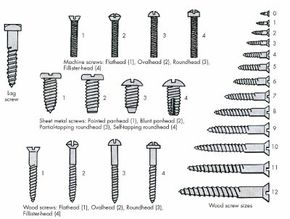For most home repair purposes, wood screws will suffice. Sheet metal screws, machine screws, and lag bolts also come in various types. If you're trying to replace one of these screws, take an old screw with you to the hardware store. The following are some of the most common screw types:
Wood Screws
Wood screws are usually made of steel, although brass, nickel, bronze, and copper screws should be used if there is potential for corrosion. For optimum wood screw performance, you need to drill first.
Sheet Metal Screws
Use this type of screw to fasten pieces of metal together. Sheet metal screws form threads in the metal as they are installed. There are several different types of sheet metal screws. Pointed pan head screws are coarse-threaded; they are available in gauges from 4 to 14 and lengths from 1/4 inch to 2 inches.
Pointed pan heads are used in light sheet metal. Blunt pan head screws are used for heavier sheet metal; they are available in gauges from 4 to 14 and lengths from 1/4 inch to 2 inches. Both types of pan head screws are available with either plain or Phillips-head slots.
Round Head Screws
Partial-tapping round head screws have finer threads; they can be used in soft or hard metals. They are available in diameters from 3/16 inch to 11/4 inches. Self-tapping screws of the round head variety are used for heavy-duty work with thick sheet metal and are available in diameters from 1/4 inch to 2 inches and in lengths from 1/8 to 3/4 inch. Both types of round head screws are available with either plain or Phillips-head slots. Plus, they are the ideal self tapping screw.
Machine Screws
Machine screws are blunt-ended screws used to fasten metal parts together. They are commonly made of steel or brass. Like other fasteners, machine screws are also made with coatings -- brass, copper, nickel, zinc, cadmium, and galvanized -- that help deter rust.
Machine screws are manufactured with each of the four basic types of heads -- flat head, oval head, round head, and fillister head -- and with both plain and Phillips-head slots. They are typically available in gauges 2 to 12 and diameters from 1/4 inch to 1/2 inch and in lengths from 1/4 inch to 3 inches.
Lag Bolts
For light work, lead, plastic, or fiber plugs (called anchors) can be used to hold screws. But for larger jobs and more holding power, lead expansion anchors and lag bolts are used. Sometimes called a lag screw, a lag bolt is a heavy-duty fastener. They are driven with a wrench and are used primarily for fastening to masonry materials or wood framing. The anchors are inserted into holes drilled in the masonry, and the lag bolts are driven firmly into the anchors.
